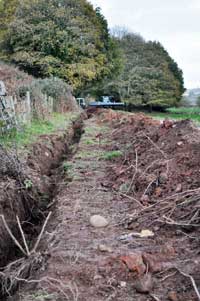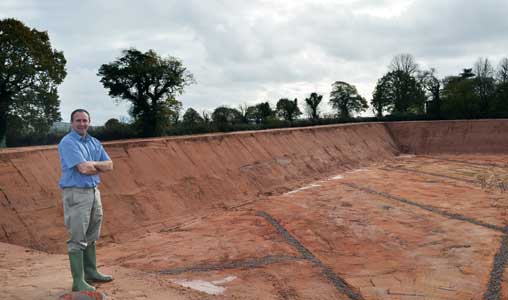Management Matters: Plan to ‘future-proof’ the farm business

Having a long-term plan provides a valuable sense of direction for the farm business, as Paul Spackman discovers at our south-west Management Matters farm
Predicting what the farm business should look like in 10 years’ time is no easy task, but it is one that Clinton Devon Farms manager George Perrott is keen to tackle.
The owners of the farm, which is part of Clinton Devon Estates, have just completed a long-term plan for the estate’s future over the next decade and it falls to Mr Perrott to set out how the farming side fits into this.
“It’s very easy to work 12 hours a day without a strategy, but I actually think it’s a crucial part of management to take the time to work out which way you’re heading in the long term,” he says. “The family and trustees have mapped out where they want to take the estate and it’s down to me to make the farm’s part of the grand strategy ‘future-proof’ for the next 10 years.”
The exact details of this “future-proofing” plan will be presented to the trustees next summer, but Mr Perrott says the focus is likely to be put on building up the organic dairy enterprise. Indeed, the farm is already making good progress in a number of areas around this.
One such example is the new £100,000 slurry storage and handling facility that is currently being built and should be in use before Christmas. The system will allow the farm to meet new Nitrate Vulnerable Zone slurry storage rules, but is also being built to cope with any future expansion of the dairy herd.
It features a 24,000cu m open-air lagoon situated in the heart of the organic arable area, with slurry and dirty water pumped to it via a 2.5km pipeline running from the main 250-cow dairy at Otter Farm. Slurry from the farm’s other 250-cow herd can also be brought in by tanker. From the lagoon, slurry will be applied using a 1500m-long umbilical system and 15m dribble bar.
“I think we’ve future-proofed the system,” Mr Perrott says. “We’ll have enough storage to cope with double the current number of cows and where it’s sited in the middle of the farm is ideal to reach most fields relatively easily. It’ll also cut out the need for hundreds of tanker journeys through the village of Colaton Raleigh.
“Even if we were to ever get out of dairying, we could potentially use the lagoon to take other liquid waste and get a gate fee for it. Likewise, if we went back to conventional production, we could still use the slurry as a fertiliser.”

But, for now at least, there are certainly no plans to exit dairying and Mr Perrott believes the future is likely to see an expansion of the herd, at the expense of a diminishing sheep flock, which has reduced from 1000 ewes to 750 this season.
“Ultimately we’re a dairy farm and I can’t see us ever going back to growing 1600 acres of cereals because we just can’t get the work rates or yields here. But we know we can produce relatively cheap milk and not at the expense of the environment.”
While he acknowledges plans to join the Higher Level Stewardship scheme have been put on hold, this avenue has not been ruled out altogether. “We’re holding out on the HLS for now. The Farm Environment Plan is valid for five years, so we could easily look again at this when the time is right.”
Invest for future
Mr Perrott says that while dairying will be the focus of the business, the arable rotation will continue to provide a valuable contribution. For that reason, he says he didn’t want to just find the cheapest way around the NVZ rules, but wanted to focus on making more of the slurry as a valuable fertiliser for the organic rotation.
“At the moment there’s nothing that makes me think we’ll be moving away from organic. This October’s milk price of 35.9p/litre is the highest we’ve ever had and I’m happy with how the arable land is performing.”
Indeed, another 190-acre tenant farm will come back in-hand next March and Mr Perrott says this will go straight into organic conversion. “At the current stocking rates of 750 ewes and 500 cows, we’ve got plenty of grazing, so we’ll be able to use some of the farm to produce forage and will probably put in a lot of spring wheat.”
Another factor to consider in the farm’s long-term plan is what will happen with the heifer replacements next year. “We’ve got 120 heifers to calve next autumn and don’t really need that many,” explains Mr Perrott. “We have to decide whether to cull hard, sell heifers, expand, or a mix of all three, which is what I suspect we might do. We’ll also have more heifers than needed for the spring calving herd next year, so a lot of these decisions will rely on what’s set out in our 10-year plan.”
Renewable future?
Renewable energy could also feature in Clinton Devon Farms’ long-term strategy, although Mr Perrott is keeping his options open at the moment. An anaerobic digestion biogas plant has been considered, but the expected £6m cost and lengthy payback has dissuaded the trustees from going down this route for now.
The estate has also looked into establishing a solar farm on a 50-acre site and has recently been in talks with three different companies. “I’m sure there is a place for solar power, but I’m not sure whether it lies in setting aside 50 or 60 acres for a ground-based system, or whether putting panels on the roof of a farm building is a more appropriate option. We’ll keep looking into this.”
A 15000kWh/year Tradewinds wind turbine has also been set up on the farm, as a test rig for the firm. “It looks quite promising so far, so there may be scope to set something up in the future,” Mr Perrott notes.
| SLURRY SYSTEM DETAILS • 24,000cu m capacity open-air lagoon • Butyl-lined • 45°, graded slopes • 6m deep, allowing 1m freeboard • Supplied via 2.5km of 6in PVC high pressure pipe, buried to a depth of 3ft • Approximate costs: o Lagoon (groundworks and liner) = £70,000 o Pipework = £25,000 (£12.50/m for materials and digging) o Planning fees & geological survey = £2000 o Fencing (320m plasti-coated mesh) = £7,000 o Total cost (including miscellaneous & contingency) = £100,000-105,000 |
|---|
Mr Perrott’s advice to others considering a new slurry lagoon:
• Options: Look at as many different systems as possible – see what works and what doesn’t
• Location: Get the location right for your farm, whether that’s next to where slurry is needed or close to where it is produced
• Homework: Work with utility companies, local council and environmental agencies to establish location of existing pipes or cables and other potential hazards. Keep the local community involved with what you’re doing and why
• Size: Make sure the lagoon is big enough – future-proof it
• Visibility: What can be done to minimise the visual impact? Consider grading slopes, grass, trees
• Security: Consider fencing, security and safety. Additional fencing may be needed to prevent badgers or foxes getting in, while cargo nets and floatation aids may be needed around the lagoon
• Due diligence: Avoid the cowboy outfits – go with a supplier you trust or is recommended. Cheapest isn’t always best
For more on slurry management see www.fwi.co.uk/nvzguidance
More information on Clinton Devon Farms
More information on other Management Matters farms

